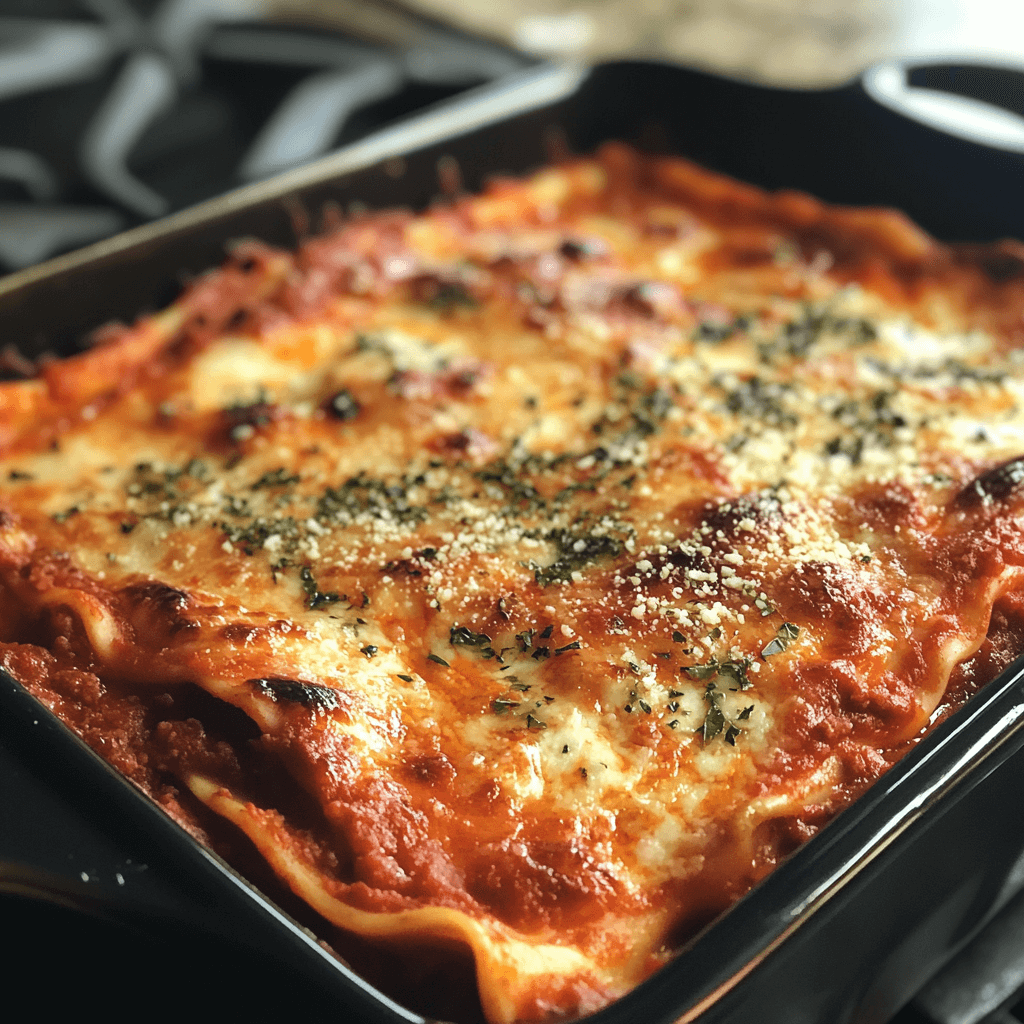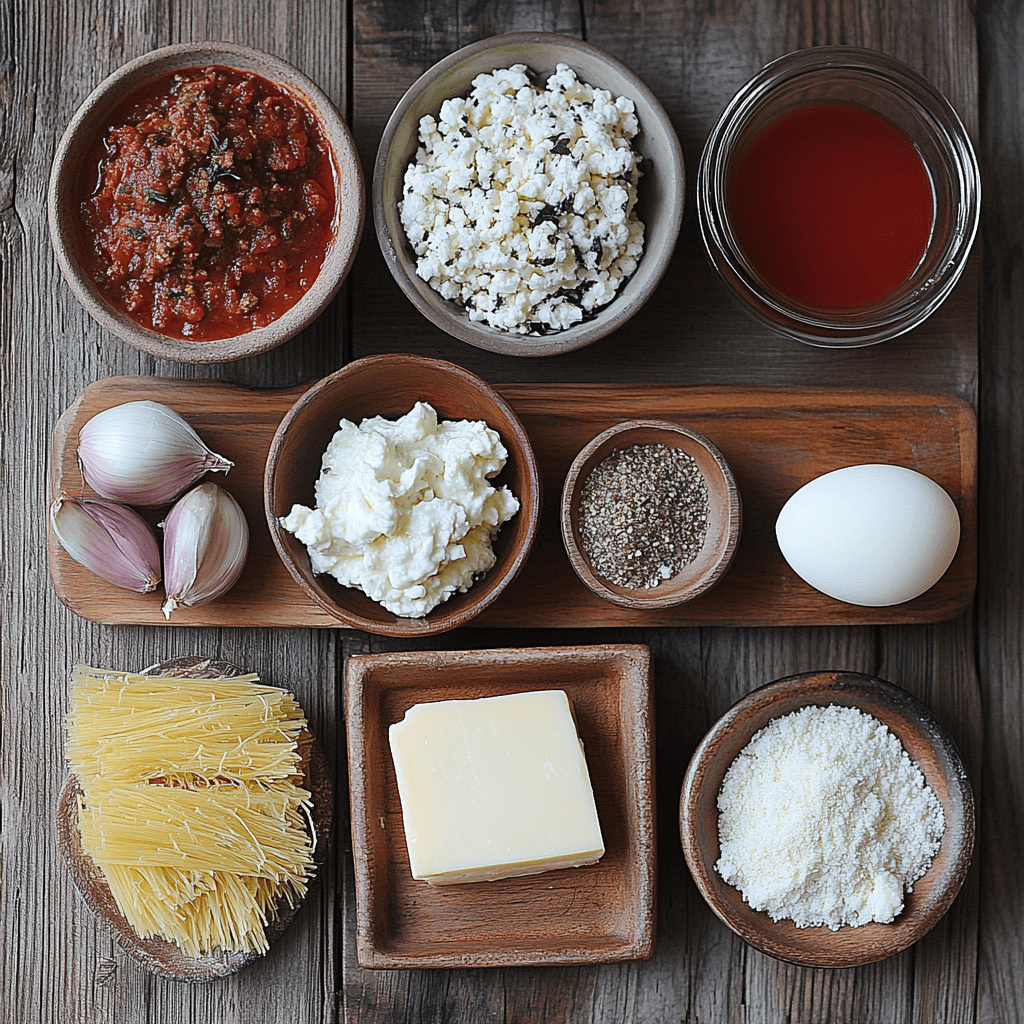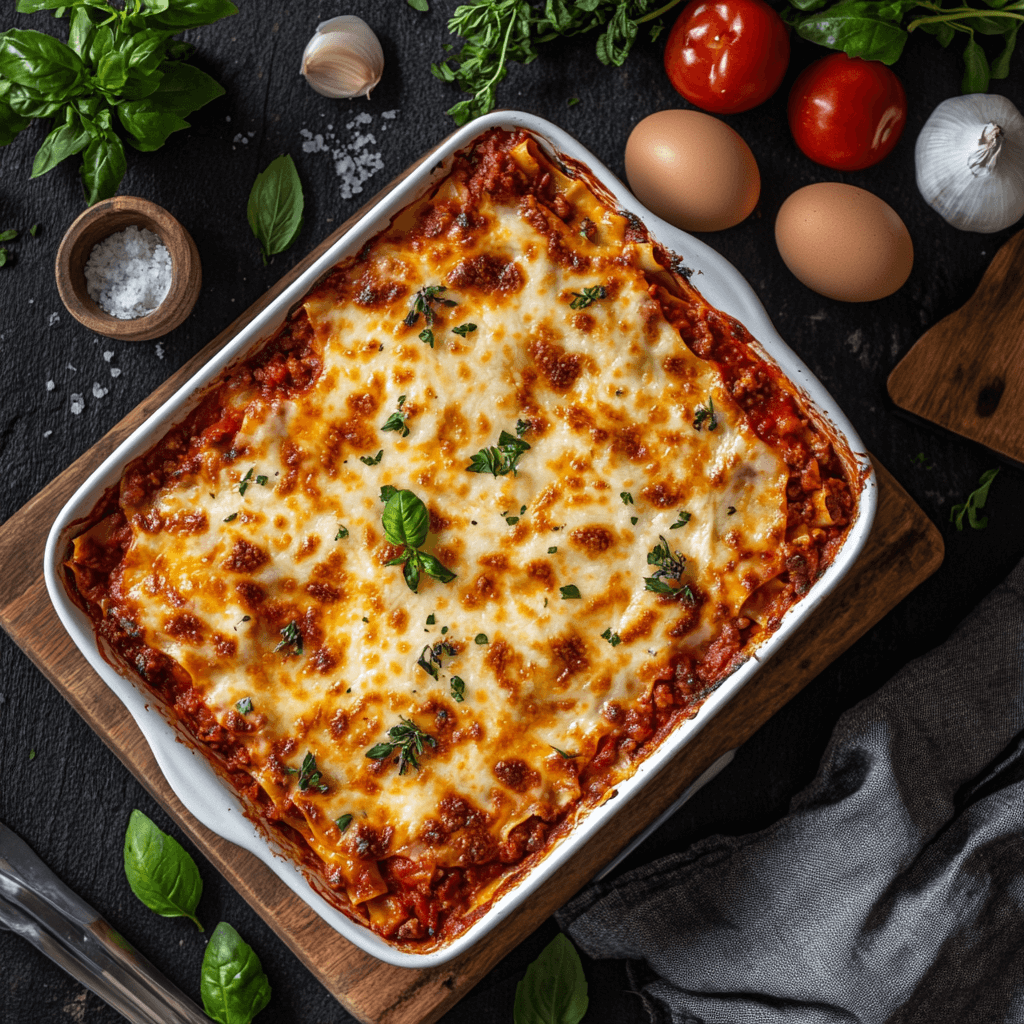Introduction
Lasagna is one of the most beloved Italian dishes, adored for its rich layers of pasta, creamy ricotta cheese, savory meat sauce, and melted mozzarella. The combination of textures and flavors makes it a comfort food that has won hearts all around the world. Whether served for family dinners, holidays, or gatherings, lasagna is a guaranteed crowd-pleaser. Its roots in Italian culinary tradition run deep, and it has evolved in numerous ways across different cultures, but its core principles remain the same. This article explores the origins, variations, and detailed steps of preparing this decadent dish.

Overview of the Recipe
Lasagna is essentially a dish made from alternating layers of flat pasta sheets, cheese (typically ricotta, mozzarella, and Parmesan), and a hearty meat sauce, traditionally made with ground beef and/or pork. The sauce is often simmered for hours to bring out its rich flavors, and the lasagna is baked until golden and bubbly. The dish has several variations depending on the region of Italy, personal preferences, and dietary restrictions.
This classic recipe involves preparing a savory meat sauce, layering it with pasta and cheese, and baking everything together to perfection. The result is a comforting, filling, and delicious meal that combines the flavors of Italy in every bite.
History and Origin
The history of lasagna dates back to Ancient Greece. The word “lasagna” comes from the Greek word “Laganon,” which referred to layers of dough. The Romans later adapted the dish by layering pasta sheets with various fillings. However, the modern version of lasagna, as we know it today, evolved in Italy, particularly in the regions of Emilia-Romagna and Naples.
It’s believed that the version we recognize with meat sauce, cheese, and pasta emerged in the 14th century. This dish became widely popular in Italy and eventually spread worldwide, especially to the United States, where it was embraced by Italian-American immigrants. Over time, different regions of Italy developed their own interpretations, with some opting for béchamel sauce (a creamy white sauce) in place of ricotta or mixing vegetables like spinach and mushrooms into the layers.
In the United States, lasagna has become a staple in many households, particularly for family gatherings, holidays, and special occasions. It’s a dish that transcends cultural boundaries, serving as a symbol of comfort and tradition.
Ingredients
The ingredients for a classic lasagna can vary slightly depending on regional differences and personal preferences, but the most common ingredients include:
For the Meat Sauce:
- Ground beef or pork (or a combination of both)
- Onion, finely chopped
- Garlic, minced
- Tomato paste or crushed tomatoes
- Tomato sauce
- Red wine (optional, for richness)
- Italian seasoning, including basil, oregano, and thyme
- Salt and pepper, to taste
- Olive oil for sautéing
For the Cheese Mixture:
- Ricotta cheese
- Mozzarella cheese, shredded (fresh or regular)
- Parmesan cheese, grated
- Eggs, for binding
- Parsley (fresh or dried)
- Salt and pepper, to taste
For the Lasagna:
- Lasagna noodles (either fresh or pre-cooked, depending on your preference)
- Olive oil (for greasing the baking dish)
For Baking:
- Mozzarella cheese (additional for topping)
- Parmesan cheese (optional for extra flavor)

Instructions
Step 1: Prepare the Meat Sauce
- Sauté the aromatics: In a large pot, heat a couple of tablespoons of olive oil over medium heat. Add the chopped onions and garlic. Cook until they become soft and translucent, about 3–5 minutes.
- Brown the meat: Add the ground beef (and/or pork) to the pot, breaking it up with a spoon. Cook until browned, about 7–10 minutes.
- Add the tomatoes: Stir in the tomato paste, crushed tomatoes, and tomato sauce. Mix well to combine. Add a splash of red wine if desired, allowing it to reduce for a few minutes.
- Season the sauce: Add Italian seasoning, salt, and pepper to taste. Lower the heat and let the sauce simmer, uncovered, for at least 30 minutes (longer if you have time), stirring occasionally. The longer it simmers, the richer the flavors will become.
Step 2: Prepare the Cheese Mixture
- Mix the cheeses: In a large bowl, combine the ricotta cheese, shredded mozzarella, grated Parmesan, eggs, parsley, salt, and pepper. Stir until well combined.
Step 3: Cook the Noodles
- Boil the noodles: Cook the lasagna noodles according to the package instructions. If using fresh noodles, this step is not necessary. Once cooked, drain and set aside. To prevent sticking, you can toss them in a little olive oil.
Step 4: Assemble the Lasagna
- Preheat the oven: Preheat your oven to 375°F (190°C). Lightly grease a 9×13-inch baking dish with olive oil or cooking spray.
- Layer the lasagna: Start by spreading a thin layer of meat sauce at the bottom of the dish. Then, add a layer of lasagna noodles, followed by a layer of cheese mixture. Repeat the layering process (meat sauce, noodles, cheese) until you have used up all the ingredients, finishing with a layer of meat sauce on top.
- Top with mozzarella: Finish by sprinkling a generous amount of shredded mozzarella and some extra Parmesan cheese over the top.
Step 5: Bake the Lasagna
- Bake: Cover the lasagna with aluminum foil and bake for 25–30 minutes. Then, remove the foil and bake for an additional 10–15 minutes, or until the top is golden and bubbly.
- Rest before serving: Let the lasagna rest for at least 10–15 minutes before cutting into it. This will help the layers set and make it easier to serve.
Pairing and Serving Suggestions
Lasagna is a filling dish on its own, but pairing it with a few complementary sides can make the meal even more satisfying.
- Garlic bread: A warm, crispy loaf of garlic bread is the perfect side to accompany lasagna, allowing you to soak up the savory sauce.
- Salad: A crisp salad with a tangy vinaigrette helps balance the richness of the lasagna. Try a simple mixed greens salad or a Caesar salad.
- Wine: If you enjoy wine, pair your lasagna with a medium-bodied red wine like Chianti, Sangiovese, or Cabernet Sauvignon.
- Vegetables: Roasted or sautéed vegetables like zucchini, mushrooms, or spinach make a great side dish and complement the flavors of the lasagna.
Variations of the Recipe
While the traditional meat lasagna is a classic, there are several variations that can cater to different dietary preferences or regional tastes.
- Vegetarian Lasagna: Swap the meat sauce for a hearty vegetable filling, such as spinach, mushrooms, zucchini, and bell peppers. Add a generous amount of ricotta and mozzarella cheese for creaminess.
- Chicken Lasagna: Instead of beef or pork, use cooked shredded chicken in place of the meat. A white sauce or béchamel sauce works well with chicken lasagna.
- Seafood Lasagna: A seafood version might feature shrimp, crab, or scallops mixed into a creamy white sauce with spinach or other vegetables.
- Gluten-Free Lasagna: Use gluten-free lasagna noodles to accommodate those with gluten sensitivities. There are also gluten-free options for the cheese mixture and sauces.
- No-boil Lasagna: No-boil noodles eliminate the need to pre-cook the pasta, saving time. Just be sure to add enough sauce to the layers for the noodles to absorb during baking.
Health Benefits Notes
While lasagna is undeniably rich and indulgent, it also offers several nutritional benefits when enjoyed in moderation.
- Protein: The meat or vegetarian filling in lasagna provides a good source of protein, essential for muscle repair and growth.
- Dairy: The cheeses used in lasagna, particularly ricotta and mozzarella, are high in calcium, which is essential for strong bones and teeth.
- Vegetables: Adding vegetables like spinach, mushrooms, or zucchini can increase the fiber and vitamin content of the dish, contributing to a balanced meal.
- Tomatoes: The tomato sauce is rich in antioxidants, particularly lycopene, which has been linked to a reduced risk of certain diseases.
Keep in mind that lasagna can be high in calories and fat, so portion control is important, especially if you are watching your diet.
FAQs
1. Can I make lasagna ahead of time?
Yes! Lasagna can be prepared in advance and stored in the refrigerator for up to 24 hours before baking. You can also freeze it for later use.
2. Can I use no-boil noodles instead of regular noodles?
Yes, no-boil noodles work just as well. Be sure to add plenty of sauce to ensure the noodles cook properly during baking.
3. How do I store leftover lasagna?
Store leftovers in an airtight container in the refrigerator for up to 3-4 days. Reheat in the oven or microwave before serving.
4. Can I freeze lasagna?
Yes, lasagna freezes wonderfully. Allow it to cool completely before wrapping it tightly in plastic wrap and aluminum foil. It can be frozen for up to 3 months.
Conclusion
Lasagna is a timeless Italian classic that combines layers of rich meat sauce, creamy cheese, and perfectly cooked pasta. It’s a dish that brings people together, whether for a casual dinner or a special occasion. With endless variations and customization options, it remains a versatile and beloved meal for families worldwide. Whether you stick with the traditional recipe or get creative with your own twist, lasagna is sure to delight anyone who takes a bite.
Recommended (Some Other Recipes)
If you love lasagna, you might enjoy these other comforting dishes:
- Baked Ziti: A similar pasta dish with a rich tomato sauce, cheese, and meat or vegetables.
- Eggplant Parmesan: A vegetarian option that replaces meat with breaded and fried eggplant slices.
- Stuffed Shells: Large pasta shells filled with ricotta cheese and baked with marinara sauce.
- Chicken Parmesan: Breaded and fried chicken cutlets, topped with marinara sauce and melted mozzarella.
- Manicotti: Tubular pasta stuffed with cheese and topped with a hearty meat sauce.

